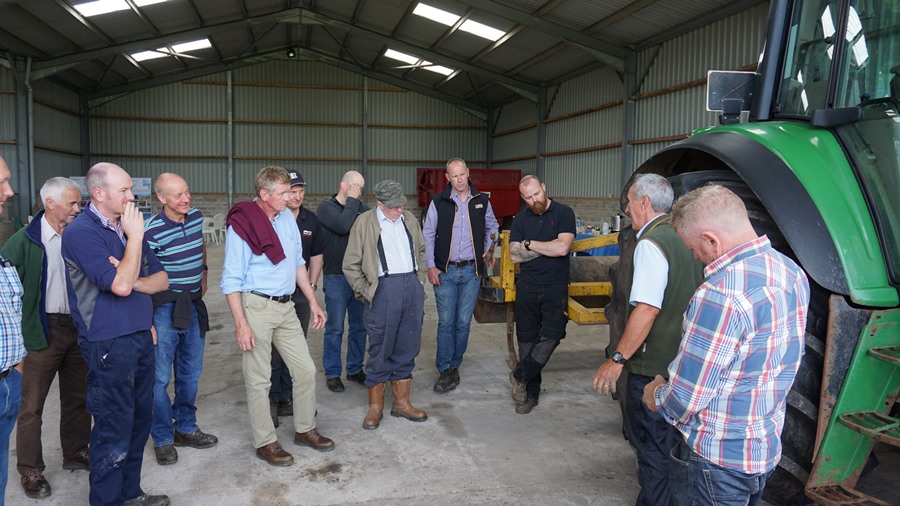Angus Soil & Nutrient Network: First meeting – Event summary
9 August 2019The first meeting of the new Angus Soil & Nutrient Network was held on Redwell Farm, with the kind permission of our new host farmer, Roy Callandar.
After an introduction to the farming system at Redwell Farm, and a bit of background information about the Soil & Nutrient Network, we were joined by guest speaker Philip Wright from Wright Resolutions Limited, a consultancy firm specialising in  agricultural cultivation and establishment machinery. Philip discussed the principles of soil management – looking at a range of topics from tyre pressures to how tines and discs interact with the soil.
agricultural cultivation and establishment machinery. Philip discussed the principles of soil management – looking at a range of topics from tyre pressures to how tines and discs interact with the soil.
The afternoon session was spent outdoors, in the field, discussing different soil health indicators whilst investigating two soil pits – one in long term fallow and one in an intensively cropped area. The session then moved on to discuss three demonstration cultivation machines which were on display and the benefits and drawbacks of each piece of equipment. This led to an engaging discussion surrounding tyre manufactures and the differences between the top of the range and budget tyres.
Philip encouraged everyone to stop and think before jumping into any job – suggesting that if we all stopped to think about how much soil we are trying to move, and then calculating the real cost of doing so, we might then think harder about whether or not it is really a necessary task.
Small alterations in working practise can have big implications for soil health. Reducing tyre pressures where possible means that any soil compaction can be limited to near the surface where it is easier to remediate. Only cultivating soil when it is really necessary can also allow soil microbes to build up, improving soil health, but financially this reduces fuel inputs and machinery wear and tear.
Key Points
- The critical depth is the depth a tine should not work below and is based on the width and length of the tine. It is a ratio between 1:5 and 1:8 depending on soil conditions. For example, a 2cm wide tine should not work deeper than 10cm if the soil is damp.
- Tyre pressure is extremely important in regards to soil compaction and tractor stability. Finding the right balance can be difficult and often depends on operation and machine.

- A handy rule of thumb is: A large weight with low pressure can push a small problem deep down the soil profile.
- Helping soil to recover isn’t a bad thing as long as the conditions allow.
- Digging a soil pit to find the problem zone and setting the machine to this depth to target this problem will have significant fuel and time savings.
Everyone who attended was offered a copy of the Valuing Your Soils booklet which can be downloaded from the link. Also offered were copies of the Technical Notes listed in the download section below, and a copy of the presentation slides used during the event.
The next meeting of the Angus Soil & Nutrient Network is being arranged for January next year. We will publish details of the event on our webpage and on social media.
- Technical Note (TN656): Soil Information, Texture & Liming Recommendations
- • Web based access to information on your soils on your farm is described. • Soil texture classes of mineral soils are described and identified by hand texturing. • Liming recommendations for different soils and managements are tabulated.
- Topics: Soils
- SAC Technical Note TN553 – Minimum Tillage
- This is a copy of SAC Technical Note TN553 - Minimum Tillage
- Topics: Crop Health, Soils and Crops and Soils
- Valuing Your Soils – Practical Guidance for Scottish Farmers
- This brochure includes useful information about Scotland's agricultural soils and practical advice outlining the upfront financial savings and business benefits of better soil management and the efficient use of resources. Action and problem-specific 'field-sheets' are designed for busy farmers with limited time for reading.
- Topics: Climate Change, Soils, Water Management and Crops and Soils
- Farming For A Better Climate: Practical Guide – Alleviating Soil Compaction
- This Practical Guide gives some ideas on how to alleviate soil compaction.
- Topics: Soils
- Farming For A Better Climate: Practical Guide – Improving Soil Quality
- This Practical Guide concentrates on how we can improve soil quality to help us to adapt to climate change.
- Topics: Soils
- Practical Guide: Tyre Selection & Management
- This practical guide explains how to reduce soil damage, improve fuel usage and reduce overall green house gas emissions by selecting the correct tyre size, type and pressure.
- Topics: Climate Change
- Presentation slides used by Philip Wright, Wright Resolutions Ltd, Aug 2019
- Presentation slides from Wright Resolutions Ltd Consultant Philip Wright, used during FAS events Aug 2019.
- Topics: Soils and Crops and Soils
Sign up to the FAS newsletter
Receive updates on news, events and publications from Scotland’s Farm Advisory Service


